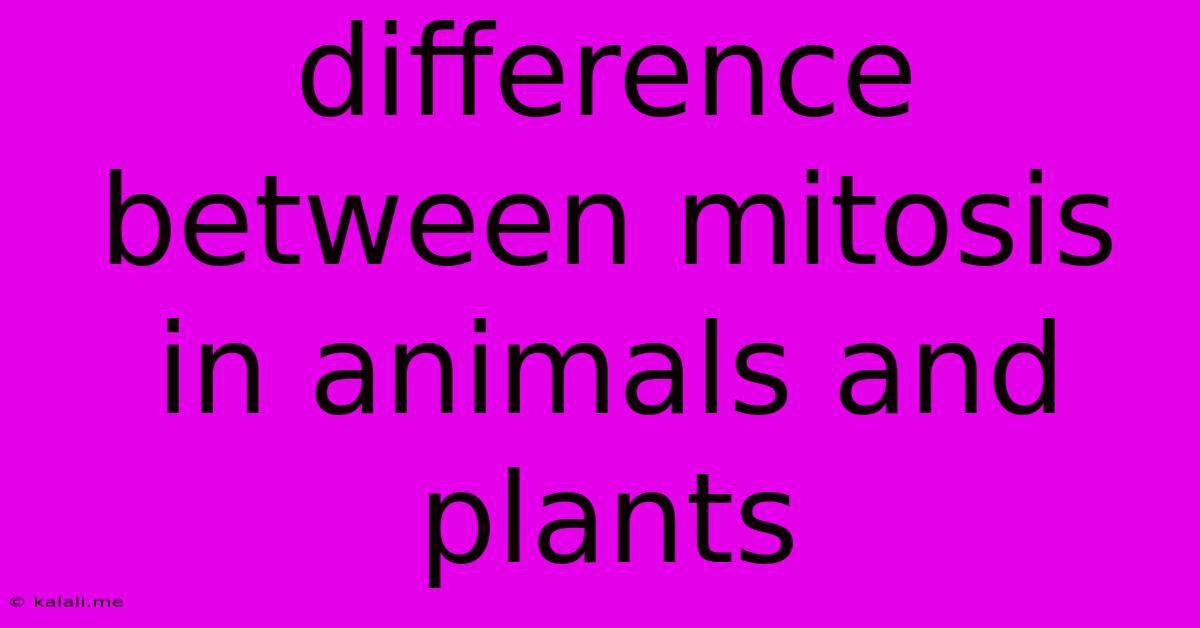Difference Between Mitosis In Animals And Plants
Kalali
Jun 13, 2025 · 3 min read

Table of Contents
The Great Divide: Unveiling the Differences Between Animal and Plant Mitosis
Mitosis, the process of cell division resulting in two identical daughter cells, is fundamental to life. While the core mechanism is similar across all eukaryotic organisms, subtle yet significant differences exist between animal and plant mitosis, primarily due to the presence of a rigid cell wall in plants. This article delves into these key distinctions, exploring the nuances of cytokinesis and the structural variations influencing the process.
Understanding the Basics: What is Mitosis?
Before diving into the specifics, let's briefly recap the common stages of mitosis: prophase, prometaphase, metaphase, anaphase, and telophase. These phases involve the condensation of chromosomes, their alignment at the metaphase plate, the separation of sister chromatids, and the reformation of the nuclear envelope. The differences between animal and plant mitosis primarily lie in the final stage – cytokinesis – the division of the cytoplasm.
Cytokinesis: The Key Distinguishing Factor
Cytokinesis is where animal and plant cells part ways. In animal cells, a cleavage furrow forms, pinching the cell membrane inwards until two separate daughter cells are formed. This is facilitated by a contractile ring of actin filaments.
Animal Cell Cytokinesis: A Cleavage Furrow Approach
- Cleavage furrow: A constricting belt of microfilaments that gradually pinches the cell membrane, effectively dividing the cytoplasm.
- Actin and myosin: These proteins play a crucial role in the contractile force responsible for the furrow formation.
- Centrioles: These are involved in organizing the microtubules that facilitate the process.
Plant Cell Cytokinesis: Building a Cell Plate
Plant cells, encased within their rigid cell walls, employ a different strategy. Instead of a cleavage furrow, a cell plate forms between the two newly formed nuclei. This cell plate, a precursor to the new cell wall, is constructed from vesicles originating from the Golgi apparatus. These vesicles fuse together, gradually expanding until they reach the existing cell wall, ultimately separating the two daughter cells.
- Cell plate formation: Vesicles carrying cell wall materials fuse together in the middle of the cell, creating a new wall.
- Golgi apparatus: This organelle plays a vital role in providing the building blocks for the cell plate.
- Cell wall deposition: The cell plate progressively thickens, eventually developing into a mature cell wall, separating the daughter cells.
Other Notable Differences:
Besides cytokinesis, some other minor distinctions exist:
- Cell Wall: The presence of a rigid cell wall in plant cells significantly influences the process of cell division, dictating the formation of the cell plate. Animal cells, lacking this rigid structure, utilize the cleavage furrow mechanism.
- Centrioles: While animal cells typically possess centrioles which play a role in spindle formation, plant cells usually lack centrioles, although the spindle apparatus still forms.
- Preprophase band: A characteristic structure, a band of microtubules, forms in plant cells before the onset of prophase. This band marks the future location of the cell plate.
In Conclusion:
While the fundamental steps of mitosis are conserved across animal and plant cells, the mechanism of cytokinesis demonstrates a significant divergence. Animal cells employ a cleavage furrow, while plant cells construct a cell plate. These differences reflect the distinct structural features and requirements of these two cell types, highlighting the remarkable adaptability of cellular processes to diverse biological contexts. Understanding these distinctions provides valuable insight into the intricacies of cell biology and the fundamental processes that drive life.
Latest Posts
Latest Posts
-
What Is The Lcm Of 14 And 10
Jun 14, 2025
-
What Is The Lcm Of 32 And 40
Jun 14, 2025
-
That Which Occupies Space And Has Mass
Jun 14, 2025
-
Which Element Has The Highest Atomic Number
Jun 14, 2025
-
Least Common Multiple Of 12 And 42
Jun 14, 2025
Related Post
Thank you for visiting our website which covers about Difference Between Mitosis In Animals And Plants . We hope the information provided has been useful to you. Feel free to contact us if you have any questions or need further assistance. See you next time and don't miss to bookmark.